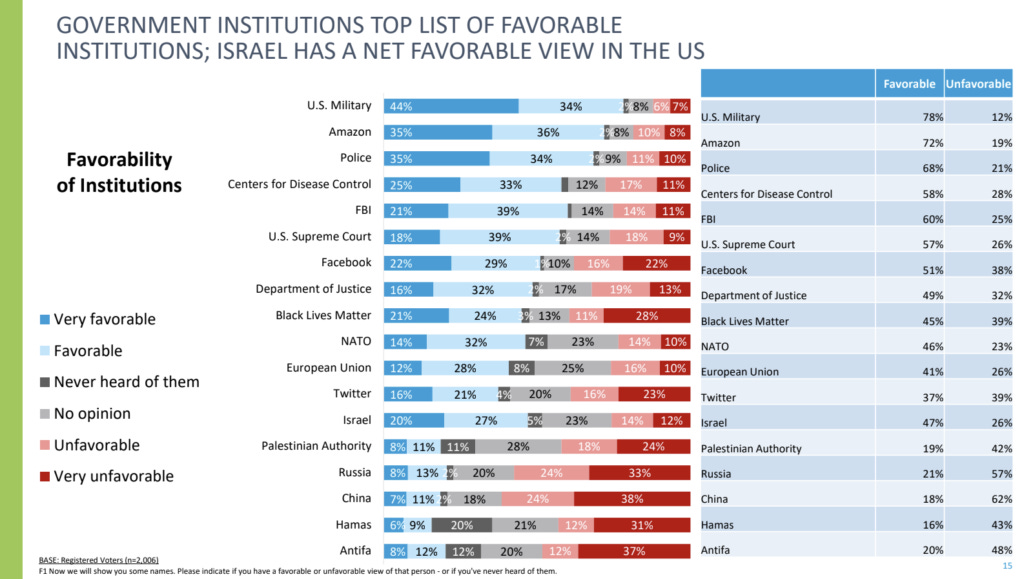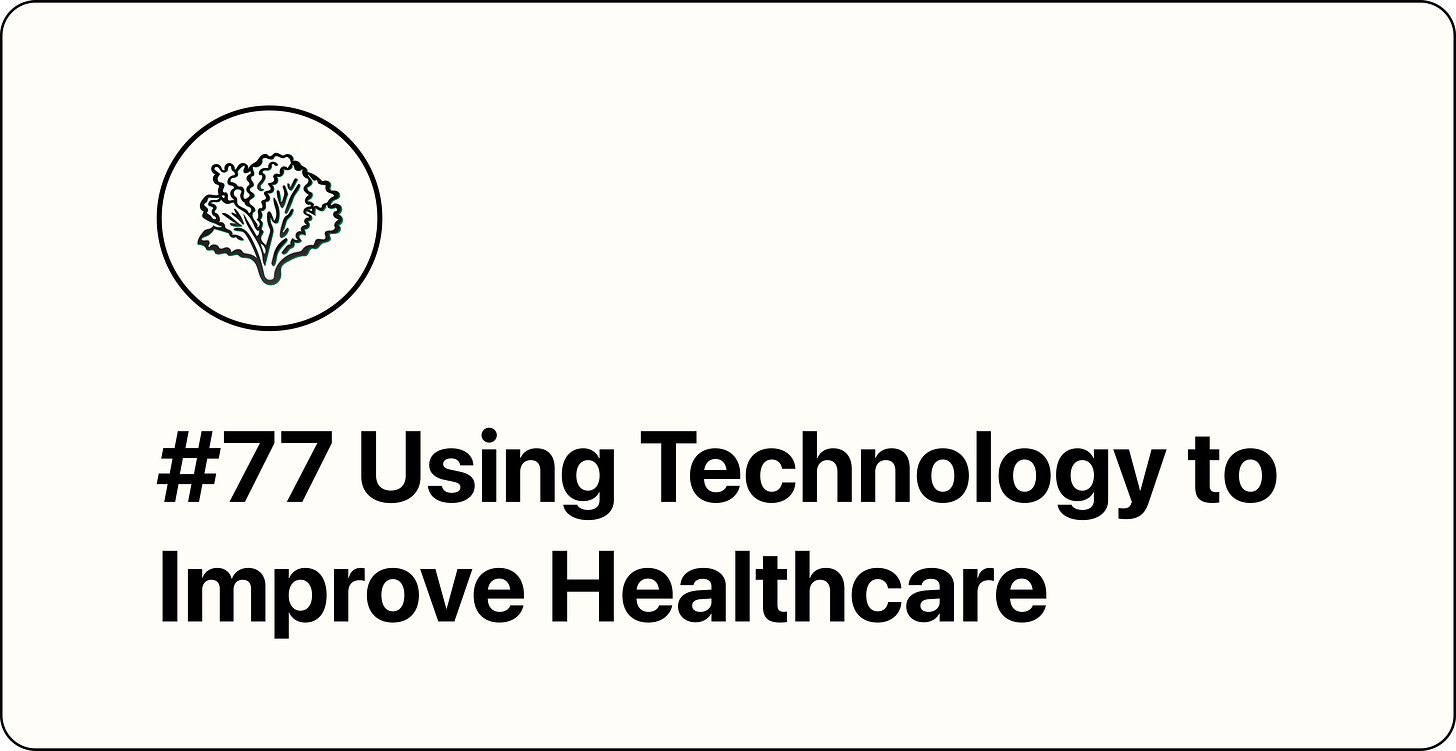#77 Using Technology to Improve Healthcare
Nikhil Krishnan aka “I got 99 problems and most of them are healthcare related”, and how technology can help us improve the US healthcare system
Comrades,
Thank you for your support of the Kale paper. It is appreciated, and I am excited for Kale’s continued growth. Commenting, liking, and sharing posts is a great service to Kale. I also recommend trying the Substack mobile app if you haven’t so far. It is my favorite ‘social media’ platform and is changing the dynamics of online reading and writing.
In the 76th edition of Kale, I mentioned an essay I read recently, titled “All of the main problems with US healthcare” written by Nikhil Krishnan aka “I got 99 problems and most of them are healthcare related”. It seems like a commonly agreed upon fact that healthcare, even in the richest nation in the history of the world, is not improving the way we’d like it to. People like Nikhil would argue it’s even getting worse. I’m no expert in healthcare, but I work with technology, have an inclination for the tech bro (and dare I say Shape Rotator) partisanship that technology can help solve problems, and have continued to think more about the overlap of technology and healthcare.
Technology permeates healthcare in many ways. What are considered the most basic tools in hospitals such as syringes, bandaids, and stethoscopes were all technological advancements at one point. Today we use tools that would be considered magic a century ago: X-rays, pacemakers, brain machine interfaces, and the application of AI to solve the protein folding problem. It's all technology. My argument is not that we haven’t adopted technology in our healthcare system, it’s that we have an opportunity to apply new tools and technologies to some of the more pressing issues we are facing in healthcare in the current moment. After reading Nikhil’s writing for some time now, it seems to me that he argues one of the fundamentally pressing issues we face in the US healthcare system is the consumer relationship with the health system, particularly economies and cost of care. We spend a larger % of total GDP on healthcare in the US than we ever have before, and from what I can find, we spend a higher % of our GDP than all the other countries in the world.1 (please correct me if i’m wrong here)
One important part of improving the consumer relationship with healthcare could have more to do with logistics. Example: Amazon applying logistics and shipping empire to deliver food at lower costs around the country. Example: Cost Plus Drugs listing pharmaceuticals at cost + 15% and building manufacturing capabilities to remove middlemen, prevent price gouging, and applying robotics and advanced manufacturing to improve the economics of drug prices.
Some ideas have some more up front cost to individuals, like wearables. Popular examples of consumer biotech tools and technologies people are consuming in the US today include Apple Watch, Oura ring, Whoop, and Eight Sleep mattresses. An example of how these tools help us include building data summaries of our sleep, activities, and diet. In return, we are able to establish more accurate summaries of our health to share with our doctors, establish more personalized baselines of our health, and understand more quickly when something isn’t right. Will Ahmed, the founder of Whoop, shared a remarkable story about a Whoop user about how their wearable helped them catch a serious issue with their heart:

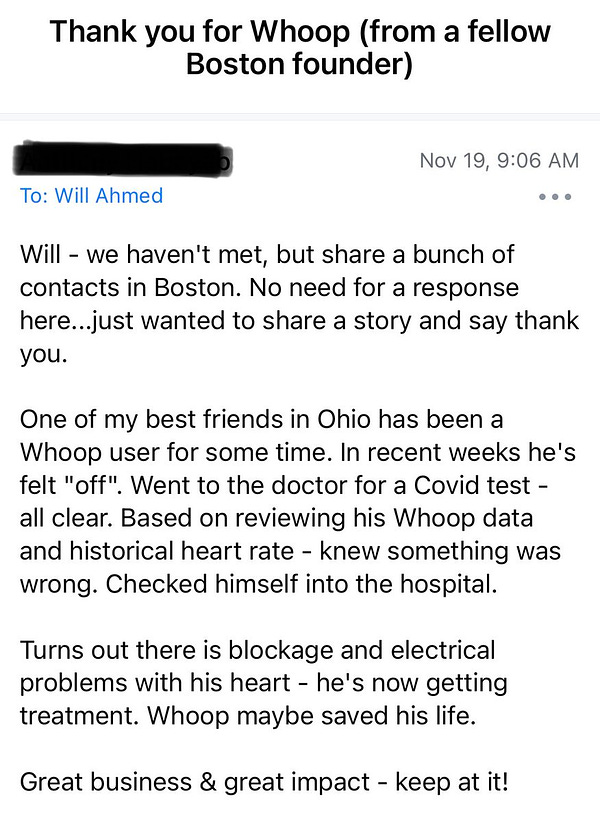
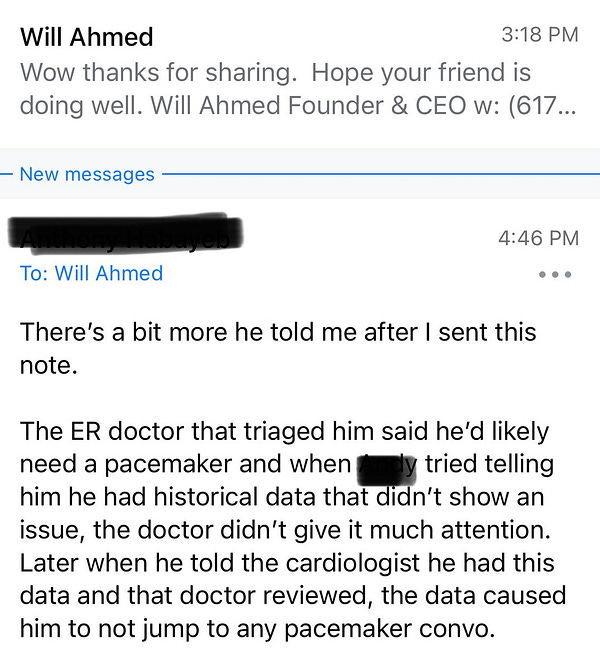
Some examples of consumer biotech services could be 23andMe for genetic testing to learn about predispositions or Inside Tracker to get blood tests and a personalized understanding of your health makeup at a molecular level. When this data is accurate and available it can be very powerful. At the same time, it’s also some of the most precious user data that exists and can be weaponized against us if it’s not protected properly. This seems to be one of the outstanding reasons people have been skeptical that our most powerful technology companies are stepping into the healthcare industry. A recent example was the discourse about Amazon’s acquisition of One Medical. According to this survey, Amazon is America’s most trusted institution behind only the US military. Even though this is the case, upon their announcement of their purchase of One Medical, the talk about the acquisition makes it seem that people are skeptical that Amazon has their best interest in mind when taking steps into healthcare. From my perspective, technology companies are the most qualified problem solvers we have, yet they haven’t gained the trust of all Americans. (never will, and it’s complicated i’m sure we can agree)

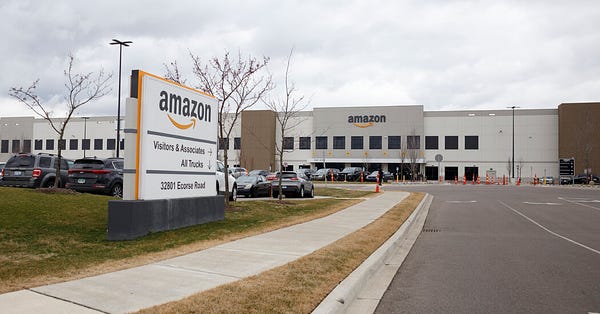
In part, the track record for even some of America’s best tech companies and how they’ve handled of user data has given people good reason to be skeptical that these companies have their customer’s best interest in mind. While this may be true, I’m skeptical of people who believe in our governments abilities to meaningfully improve the state of the US healthcare system alone. Dare I stretch and say that politicians may not have our best interest in mind either. Multiple things may be true. Technology companies, governments and politicians all will have a role to play in improving the state of our healthcare system, and people will be right to be skeptical along the way.
What’s my point? Data privacy is going to be a critical part of allowing technology companies leverage their ability to solve problems in healthcare. This was one important part in my essay “It's Time to Give Tim Cook the Credit He Deserves”. Companies that are principled enough to care about building their products and services with this principle in mind are going to be a big part of improving the state of healthcare in the US. At the foundation is technology and data privacy protections. Naturally, technology is a necessary ingredient to solve some of the issues Nikhil Krishnan talks about in his essay “All of the main problems with US healthcare”. Many of his claims stem from incentive misalignment, but I picked a few issues where it seems technology could have the most immediate impact.
Volume-Based Business Models + Healthcare Consumption
One of the issues Nikhil expands on is volume-based business models and healthcare consumption. At the core, this is incentive misalignment in the business models across the healthcare industry.
Fee-for-service, # of drugs sold, etc. So many issues in healthcare can be tied to a downstream effect of the incentive misalignment that happens when you’re incentivized to “do more healthcare”.
How can technology play a role in improving this issue? To some degree, a restructuring of incentives is more likely a more fundamental solution but I think technology could play a role in minimizing healthcare consumption.
One example would be the evolution of at home testing. The last covid and strep test I took at the doctors office was covered by my insurance, but the bill was roughly $1,000 dollars. By building services to enable consumers to test at home as opposed to at the doctors office, we can limit the in person testing consumption by some degree. Again this does not solve the fundamental issue of why my last covid + strep test costed a thousand dollars but it would maybe improve the situation, and would have some other positive consequences like limiting a sick person’s exposer to other people.
Another example of technology’s impact to reduce an individuals healthcare consumption would be personal health monitoring. Personal health monitoring is an area where wearables and biotech tools can have a massive impact. If I can have accurate picture into my most personal health metrics such as HRV, blood oxygen, blood pressure, and so on; I can limit my need to go to the doctor’s office to be tested for these things. More-so, personal wearables and biotech tools may give me additional metrics I couldn’t get at the doctors office such as sleeping measurements and can help an individual establish their own personal baseline measurements as opposed to generic ones based on basic variables like age, gender, etc. This is revolutionary for many reasons. Like mentioned with Whoop earlier^, these baselines, and deviations from these baselines can help an individual understand when something is off before they’re showing physical symptoms. For less serious illnesses, one could share these baseline deviations with a doctor using tele-health, get diagnosed, and prescribed the proper medicine all without actually visiting the doctor. For more serious illnesses, one could share these deviations from their baselines with their doctors, use at home tele-medicine to troubleshoot to find the problem, and escalate to in person care as appropriate. This would allow the healthcare to treat serious illnesses earlier, improve patient outcomes, and ideally further limit overall healthcare consumption for that individual.

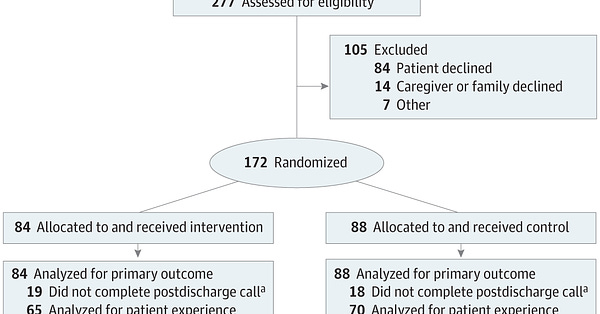
The Data Problem
There is not just one data issue in healthcare. Nikhil mentions some of our most pressing data problems to be:
Payment, price, and billing data
Health record and EMR data
Data standards
Data is siloed, in different places/formats, and has a massive time lag.
Which of these problems can be improved by leveraging technology? One place I believe technology can have the greatest impact is personal health records and data portability. Again, individuals have a reason to be skeptical of who is managing their personal healthcare data. However, if people are given the tools to build a detailed personal health history, and share it with their doctors and care providers when needed; cost of care could theoretically go down while quality of care improved. Let’s imagine I’m using an Oura ring and Eight Sleep mattress to track a bunch of my most critical sleep metrics, and I’m using an Apple Watch and some of my Oura metrics to monitor my daily activity and health metrics. I can use those data summaries to create a picture of my health that can be shared with my doctor during checkups without doing a bunch of testing, and even have access to data that wouldn’t be available on a one time checkup. Further, let’s imagine I can use apps like Apple Health to log blood tests I’ve done in the past so I can share this data with my doctors. One step further, let’s imagine there was a way keep old x-rays, questionnaires, and insights from past doctors visits to be shared with my doctors and health care providers when needed. All of these examples require strict data privacy protections to avoid dystopian outcomes, but if leveraged properly, could improve care while decreasing cost of care. Less repeat testing, a more dense picture into your health history, higher likelihood of mapping and correlating data insights to root issues. It is important that this data is owned and controlled my individuals, protected at all costs, portable, and available when necessary.
Another place technology could harness data to decrease the cost of care while improving health outcomes is blind data pooling. What if everyone has access to all this robust personal health data, and was able to share it blindly upon their permission, to give a more holistic picture of a society. Why would this be useful? One example would be in a pandemic, where doctors and scientists would be able to get a more accurate picture of what is happening without sacrificing individual privacy. Another example of how this may be helpful is more accurate insights into a populations health. We may be able to create more robust and accurate pictures about what is normal for different people, who do different things, with different conditions, different genders, different ages, and so on. This seems inevitable and useful. But extremely important that it is done in the right way. Done in a way where individuals opt in, have control to opt out, and in a blind fashion.
One more reason blind data pooling, combined with personal health monitoring for more robust individual health data, could be useful, is to create more accurate correlations and causations for sickness and diseases. Using AI and machine learning to develop more accurate understanding of causation and correlation of diseases may be one of the greatest advancements for the human race in the coming decades. More robust and accurate personal health data, combined with security measures to ensure personal control over that data, and then use to understand disease better; it’s a revolution that could increase lifespan, reduce human suffering, and improve the economics of healthcare.
Structural system failures and unhealthy lifestyles
Lastly for this essay, how can technology improve preventative care and unhealthy lifestyles for individuals in the US healthcare system? The US is dealing with a health crisis of epic proportions. The cost of treating the externalities will continue to rise. One of the best ways we can treat diseases is to prevent them the first place. Tapping into our boy Nikhil’s expertise once again, here are some statistics from his essay “Food as Medicine”.
Pre-pandemic, 10.5% of US households saw some form of food insecurity, jumping to 23% during the pandemic (potentially closer to 30% for households with children). This disproportionately impacts black and hispanic communities.
About 19 million people live in a food desert (an urban area in which it is difficult to buy affordable or good-quality fresh food) -- though accessibility to grocery stores has actually gotten better over time.
There’s an obesity epidemic, with prevalence jumping from 30.5% in 1999-2000 to 42.4% in 2017-2018 in adults. Relatedly, the prevalence of obesity-related conditions like cardiovascular disease, diabetes, etc. is also increasing rapidly.
While general food costs have increased about 2% per year (approximately in line with inflation), fresh vegetables have grown closer to 4% per year. This is even higher in some food deserts.
With inflation at its highest level in the US in over 40 years2, and even worse in most places around the world, food prices are high. To address cost and access to healthier foods, it will be important address both logistics of growing healthier foods for less while also building the logistics platforms to ensure people everywhere in the country have access to these foods. Better logistics and delivery capabilities will allow more people to have access to fresh produce and ideally reduce our reliance on processed foods. Improved logistics could also make Nikhil’s vision for “the doctor to “order” food for patients” come true.
Another way we can improve preventive health is to give people access to more robust diet and exercise data. How can technology help us improve our diet, exercise, and preventative health? This seems to be a core use case for wearables; where you can capture a more accurate picture of your activity, how your body is responding to the things you’re doing and the things you’re consuming, as well as give doctors a way to look at a more expansive summary of a patients health.
I’m sure there’s more. What do you think?
Lucas
https://www.statista.com/statistics/268826/health-expenditure-as-gdp-percentage-in-oecd-countries/
https://abcnews.go.com/Business/explainer-inflation-high-happened-time-reached-level/story?id=88108218#:~:text=When%20was%20the%20last%20time,bankers%20in%20a%20difficult%20position.




